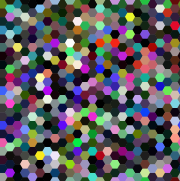Creating a mostly-random color generator

Fully randomized colors
In the previous two posts we’ve explored how to draw and tile hexagons, creating images that can be seamlessly repeated. We also briefly covered coloring them using a random color generator. The coloring process itself worked fine, but many times the created tiling turned out not very visually appealing, the colors of too harsh a contrast in tone and brightness.
In this post we’ll cover the creation of a mostly-random color generator. One that creates random colors within a certain fraction of the available colorspace.
Picking a color representation
There are a few different ways to describe colors in RGB colorspace, providing us with different approaches on how to restrict the available portion to select colors randomly from:
- RGB: Red, Green and Blue values — A direct representation of the intensity of each of the color components.
- HSV: Hue, Saturation, Value (brightness) — A cylindrical color mapping, common in color wheels in various graphics programs
- HSL: Hue, Saturation and Lightness — Another cylindrical color mapping, similar to HSV but with a few different behaviors which we’ll discuss in a moment
Any of the above could be used, and all three have potentially interesting behavior when certain values are kept constant, or only allowed to vary by a small amount. If we would like a behavior where we can restrict the hue of the color but have full variation in lightness and color intensity, the direct RGB mode is ruled out.
The choice between HSV and HSL mostly comes down to a matter of taste. Intuitively, when I read a color where all three channels are maxed, I would expect that to be a fully saturated and maximally intense color. HSV …